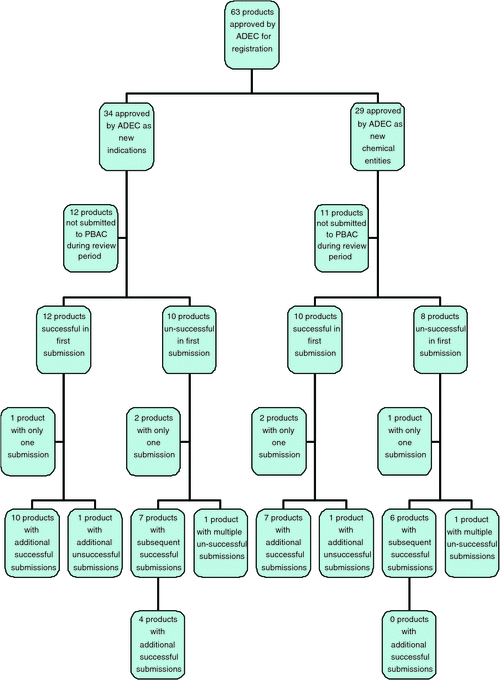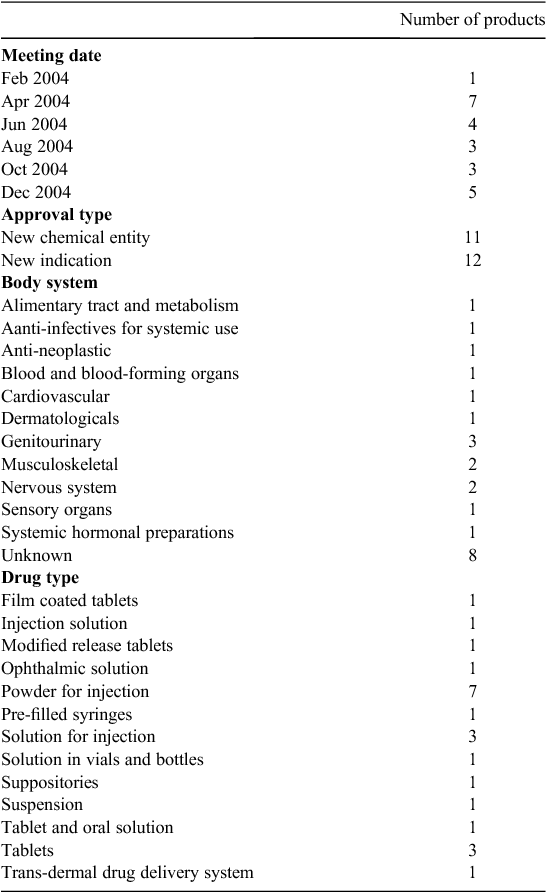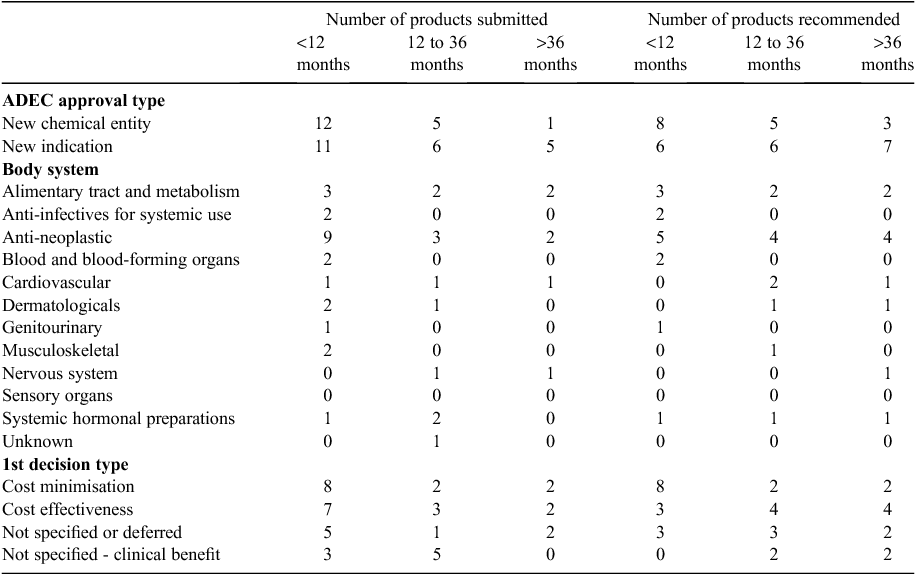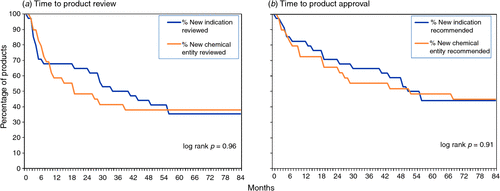Delays in access to affordable medicines: putting policy into perspective
Alison Pearce A B , Kees van Gool A , Philip Haywood A and Marion Haas AA Centre for Health Economics Research and Evaluation, University of Technology, PO Box 123, Broadway, NSW 2007, Australia. Emails: kees.vangool@chere.uts.edu.au, phil.haywood@chere.uts.edu.au, marion.haas@chere.uts.edu.au
B Corresponding author. Email: alison.pearce@chere.uts.edu.au
Australian Health Review 36(4) 412-418 https://doi.org/10.1071/AH11110
Submitted: 8 November 2011 Accepted: 19 April 2012 Published: 15 October 2012
Journal Compilation © AHHA 2012
Abstract
Background. To save costs, the Australian Government recently deferred approval of seven new medicines recommended by the Pharmaceutical Benefits Advisory Committee (PBAC) for up to 7 months.
Objectives. The aim of this research is to examine the timelines of PBAC applications following approval by the Therapeutic Goods Administration (TGA), allowing the recent Cabinet delays to be considered in the context of the overall medicines approval process.
Methods. All new chemical entities and products for new indications approved in 2004 by the Australian Drug Evaluation Committee (ADEC) were identified. Outcomes of PBAC meetings from 2004 to 2010 were then searched to identify if and when these products were reviewed by PBAC.
Results. ADEC recommended 63 eligible products for registration in 2004. Of the 113 submissions made to PBAC for these products, 66 were successful. Only 43% of the products were submitted to PBAC within 2 years, with an average 17-month delay from TGA approval of a product to consideration by the PBAC.
Conclusions. Cabinet decisions to defer listing of new medicines delays access to new treatments. This occurred in addition to other longer delays, earlier in the approval process for medicines, resulting in a significant impact on the overall timeliness of listing.
What is known about the topic? There is evidence that the time from registration of new drugs on the TGA to their listing for subsidised availability is increasing. The government’s recent decision to delay the listing of seven new drugs for subsidisation raised concerns about the potential for additional delays to impact the accessibility of new, affordable medicines for patients.
What does this paper add? This paper examines delays at various stages in the process of approval for pharmaceutical subsidies on the Pharmaceutical Benefits Scheme (PBS), putting the deferral of new medicine listings in the overall context of the approval process. It identifies the potential role of pharmaceutical companies and product sponsors in delaying access to new, affordable medicines early in the approval process.
What are the implications for practitioners? Delays in the subsidisation of medicines, wherever they occur in the process, not only reduce patient access, but may also lead to pressure in other areas of the health care system to finance such medicines. This makes these results of particular interest to clinician managers, health care managers and policy makers.
Introduction
In February 2011 the Australian Government announced that it would defer the listing of seven medicines on the PBS and that all future listings would now be considered by Cabinet. The Minister for Health characterised these decisions as cost-saving measures to ensure the long-term sustainability of the Pharmaceutical Benefits Scheme (PBS).1
Prior to the February announcement, positive recommendations made by the Pharmaceutical Benefits Advisory Committee (PBAC), which were expected to cost the government less than $10 million per annum in the first 4 years of listing, were routinely approved by the Health Minister and listed on the PBS.2 Positive recommendations costing over this threshold required Cabinet consideration.2 Only twice has a positive recommendation been rejected by the government, in both cases due to the large predicted budget impact on the PBS of high demand for the products (sildenafil citrate (Viagra) and nicotine patches).1 This system was considered a leading example internationally of a fair, transparent, equitable, accountable and independent process for listing subsidised medicines.3,4
Controversy has surrounded the government’s decision to defer subsidies for new medicines recommended by the PBAC. The Senate Finance and Public Administration References Committee produced a report highly critical of the government’s decision.1 One of the major concerns was the impact the delays may have on the accessibility of affordable and appropriate medicines to patients.1
One of the seven drugs deferred in February 2011 was approved for listing by the government in June 2011, with the remaining six approved in September 2011. These products were therefore delayed for between 4 and 7 months. An eighth product was deferred in September 2011 pending a commissioned review. This controversy highlights that the focus of public attention and policy is often on delays at the end of the approval process; however, there are several other stages at which subsidised patient access may be delayed. One of these is the time taken by pharmaceutical companies to submit applications to the PBAC. The aim of this research is to examine the timelines of PBAC applications following approval by the Therapeutic Goods Administration (TGA). This stage arguably is where sponsors (who are generally pharmaceutical companies) can exert the most control over timing. Our descriptive analysis will allow us to consider the recent Cabinet delays in the context of the overall medicines approval process.
Methods
All new chemical entities and products for new indications registered by the TGA in 2004 were identified through the Australian Drug Evaluation Committee (ADEC, known since 2010 as the Advisory Committee on Prescription Medicines) meeting minutes, published online.5–10 The year 2004 was selected as the base year, as this is the first year in which PBAC meeting minutes were made public and available on the PBS website, therefore maximising the timeframe available to follow the progress of products through to PBAC submission. The ADEC approvals for new dosages, new dose forms, new fixed combinations and new or changed populations were excluded from the analysis because ‘products are approved by ADEC for a specific indication, and in general PBAC does not recommend a product to be listed for indications beyond those registered’ (p5).11 However the restrictions placed on a product by PBAC are often narrower than those imposed by the TGA. This means that while a sponsor may be required to resubmit to the PBAC to expand the dosage form or eligible population, the original TGA listing would not require a change.11 By restricting to new chemical entities and new indications, we ensure that each PBAC application is associated with a specific ADEC approval.
The online minutes of PBAC meetings held between March 2004 and August 201012 were searched to identify if and when these products for the specified indication were reviewed for listing on the PBS. For products where the PBS review process was not clear, the Public Summary Documents were also reviewed.
The time from ADEC approval to PBAC review and recommendation, which includes the 17 week PBAC review period, was then calculated. Descriptive statistics were generated for rates of approval and time from ADEC approval to PBAC review and recommendation. Exploratory comparisons of time to review based on success of first submission and ADEC approval type were performed using nonparametric tests. Nonparametric tests were selected as the data were positively skewed.
Results
ADEC met six times in 2004, and recommended 91 products for registration.5–10 Sixty-three of these products were approved as a new chemical entity (n = 29) or for a new indication (n = 34) and were therefore included in this study. Of the included products, anti-neoplastic agents were the most common (n = 8), followed by alimentary tract and metabolism agents (n = 6 each), and cardiovascular, dermatological, genitourinary, musculoskeletal, nervous system and systemic hormonal preparations (n = 4 each).
As at August 2010, the 63 TGA-listed products had resulted in 113 PBAC applications. Reviewed products were submitted to PBAC an average of 2.8 times (median twice, range 1–7). Fig. 1 describes the flow of products through ADEC and PBAC submissions. Twenty-three products had not been submitted to PBAC, and these were evenly distributed between new chemical entities and products for new indications (Table 1).

|

|
Approvals
Of the 113 submissions to PBAC, 66 were successful. Of the 63 products, PBAC had approved 35 by August 2010. Twenty two products were approved at first submission. The thirteen products which were not approved at the first review but have since been approved received a total of 27 negative or deferred decisions before the approval. The PBAC provided no specific basis for nearly half of the approvals (n = 30), twenty-one were approved on the basis of cost minimisation, and fifteen on the basis of favourable cost effectiveness.
Rejections
Forty-one submissions were rejected and six were deferred. Submissions were rejected primarily on the basis of unacceptable cost effectiveness (n = 19) or uncertain clinical benefit (n = 19). No specific reason was provided for two rejections, and one rejection was on the basis that the total cost to the PBS was unclear.
Timing
There was an average of 507 days (median 274 days, range 29–1675 days) between the ADEC approval for a new indication or new chemical entity and its first review by the PBAC. Products which were approved averaged 702 days (median 577 days, range 29–2038 days) to first approval.
Within 6 months of ADEC approval 16 of the 63 new chemical entities or new indications had been reviewed, and 10 approved. After 1 year this rose to 23 reviewed, and 14 approved. After 2 years 27 products were reviewed and 20 approved. No products were reviewed between 4.5 and 7 years after ADEC approval, and no product was approved between 5.5 and 7 years after initial ADEC approval. Table 2 provides details of the product characteristics by time to first review and first approval.

|
Overall, products approved at the first review took no longer to be submitted for review than those that were rejected the first time (mean 575 days v. 425 days (P = 0.396), median 243 v. 274 days). Those products that were not approved at the first submission took an average of 538 additional days (median 365 days) to obtain PBAC approval, with a range of 122–1219 days.
The categories of anti-infectives, genitourinary, musculoskeletal and blood and blood-forming organs had a markedly lower average time to first review (medians of 31, 151, 46, 212 days) than did products in other categories. Products approved by ADEC as new indications were equally likely to be submitted (63%) and approved (53%) as were products that were approved as new chemical entities (62% and 55%). Using censoring to account for products never submitted, new chemical entities did not take as long as did new indications to be submitted to the PBAC (median 577 v. 1004 days). Fig. 2 shows the time to review and recommendation of products approved as new indications compared with new chemical entities.

|
Discussion
Previously available data provide information on the overall time between TGA approval and PBS listing.13 These reports suggest the average time between a positive TGA recommendation and PBS listing had increased steadily from 13.6 months in 2000 to 34.2 months in 2009.13 Our review examines this process in more detail by looking at the timeliness of different stages in the approval process. There are many factors and incentives that may lead to the delays in the approval process seen in this analysis, and several recent policy changes aimed at improving timely access to subsidised medicines have been implemented in recent times.
One such policy change is the signing of a Memorandum of Understanding (MOU) in September 2010 between the Department of Health and Ageing, and Medicines Australia.14 The MOU was designed to improve the efficiency and sustainability of the PBS, as well as provide certainty about pricing policy to the pharmaceutical industry in Australia. The MOU covered issues such as pricing, comparators, managed entry and maximum time frames between PBAC recommendation and listing.14 Many critics of the Cabinet decision to defer listing of new medicines felt that the decision breached the provisions of the MOU, which stated that if Cabinet was required to review PBAC recommendations, this would be done within 6 months.1,4,15 The MOU also addresses the issue of time from registration to subsidisation through introduction of parallel submissions. The MOU is in effect until June 2014.14
We found that only 43% of products approved for TGA listing are submitted to PBAC within 2 years. Some delays may be caused by the need to obtain additional evidence on efficacy and cost effectiveness, which may not be available at the time of TGA listing. However, these delays could potentially be minimised by collecting additional data alongside TGA-required evidence. As part of the Memorandum of Understanding, a parallel process of TGA and PBAC submission took effect from January 2011.14 While a product must still be listed on the Australian Register of Therapeutic Goods before it is listed on the PBS, the ADEC and PBAC committees can now receive submissions for a product in parallel.14 The aim is to reduce the time from registration to reimbursement, and to provide patients with earlier access to medicines.16 Since coming into effect five products (linagliptin in July 2011, and testosterone solution, ivabradine, mycophenalate sodium and rifaximin in November 2011) have had PBAC decisions deferred until ADEC recommendations are made.12
The costs of preparing a PBAC submission could be prohibitive for sponsors, and delaying may be a budgeting tool used particularly when the success of a product is in doubt. Although not in place during this review, since January 2010 cost recovery fees have applied to PBAC submissions. The cost of a major submission includes a lodgement fee of $119,500. There have been several criticisms of this policy, including that it could be a significant deterrent to expedited applications to the PBS,17 particularly for medications with relatively small markets.18,19 An independent review of the impact of the PBAC cost-recovery scheme commenced in August 2011, and is due to provide a report to the Minister to be tabled in Parliament in early 2012.20
It is also possible that the introduction of PBAC recovery fees now means that application costs outweigh the potential profits from subsidised sales.18,19 It has been reported that The Pharmacy Guild states over 30% of drugs currently listed on the PBS have annual sales of less than $100,000 nationally, making them unprofitable under the current cost-recovery scheme.19 Under these circumstances companies may choose not to apply for PBS listing and look for alternative ways of selling and marketing products directly to individuals,18,19 or through funding available through special access schemes, private insurance companies,21 hospitals22 or charitable organisations (in rare cases).
The availability of alternative sources of funding for medications creates fewer incentives for pharmaceutical companies to apply for PBS listing. This disincentive to list may be reinforced by the price-volume tradeoff faced by companies going through the PBS listing process. If their product is listed, the company negotiates with the Pricing Authority to agree an appropriate price. While listing may increase the volume of a product sold, the reduction in price required to obtain PBS listing may reduce overall profit.
This review found that only 32% of products approved for TGA listing are recommended by the PBAC within a 2-year period. Under the Australian-United States Free Trade Agreement, the Australian Government has endeavoured to improve the timeliness of positive PBAC recommendations being implemented as listings on the PBS, as well as making expedited PBAC reviews available.23 The PBAC cycle is currently 17 weeks, from the application closing date to the PBAC meeting. This timeframe allows for independent evaluation of each submission, and reviews by the PBAC economics, drug utilisation and pricing sub-committees.
This review presents a descriptive analysis of the time from ADEC approval of a new chemical entity or product for a new indication to PBAC review and recommendation for listing on the PBS. Whilst it is limited by a lack of control for covariates, our results show that the average time from TGA listing to first PBAC review was 17 months (507 days), and that 55% of first time submissions were successful.
Conclusion
This paper puts Cabinet decisions to defer listing of new medicines in the overall context of the approval process. Whilst there is no doubt this decision has delayed access to new treatments, there are other delays earlier in the approval process that also have a significant impact on the overall timeliness of listing. Several recent policy changes have been implemented that may address some of these delays, and improve timely access to affordable new medicines for Australians.
Conflicts of interest
The authors declare there are no competing interests.
Acknowledgements
This work was supported by a 2010 University of Technology, Sydney Faculty of Business Grant.
References
[1] The Senate Finance and Public Administration Committee. The Government’s administration of the Pharmaceutical Benefits Scheme. Canberra: Senate Printing Unit; 2011. Available from: http://www.aph.gov.au/senate/committee/fapa_ctte/pharma_benefits_scheme/index.htm [verified September 2011][2] Australian Government Department of Health and Ageing. The listing steps. Commonwealth of Australia; Available from: http://www.pbs.gov.au/info/industry/listing/listing-steps [verified August 2011]
[3] Mental Health Council of Australia. Submission to the Senate Finance and Public Administration Reference Committee Inquiry into the Governments Administration of the PBS. 2011. Available from: <http://www.mhca.org.au/documents/submissions/MHCA%20Submission%20to%20the%20Senate%20Inquiry%20into%20the%20Government’s%20adminsitration%20of%20the%20PBS.pdf> [verified August 2011]
[4] Bennett CA. Opening remarks to Senate Finance and Public Administration Reference Committee Inquiry into the Governments Administration of the PBS 2011. Available from: <https://www.chf.org.au/pdfs/chf/Opening-remarks-PBS-Senate-Inquiry-July-2011.pdf> [verified September 2011]
[5] Australian Drug Evaluation Committee. Gazettal Notice Therapeutic Goods Act 1989 Australian Drug Evaluation Committee Recommendations. Commonwealth of Australia Gazette GN 8, 25 February 2004. Available from: http://www.tga.gov.au/archive/committees-adec-resolutions-0232.htm [verified September 2011]
[6] Australian Drug Evaluation Committee. Gazettal Notice Therapeutic Goods Act 1989 Australian Drug Evaluation Committee Recommendations. Commonwealth of Australia Gazette GN 17, 28 April 2004. Available from: http://www.tga.gov.au/archive/committees-adec-resolutions-0233.htm [verified September 2011]
[7] Australian Drug Evaluation Committee. Gazettal Notice Therapeutic Goods Act 1989 Australian Drug Evaluation Committee Recommendations. Commonwealth of Australia Gazette GN 27, 7 July 2004. vailable from: http://www.tga.gov.au/archive/committees-adec-resolutions-0234.htm [verified September 2011]
[8] Australian Drug Evaluation Committee. Gazettal Notice Therapeutic Goods Act 1989 Australian Drug Evaluation Committee Recommendations. Commonwealth of Australia Gazette GN 35, 1 September 2004. Available from: http://www.tga.gov.au/archive/committees-adec-resolutions-0235.htm [verified September 2011]
[9] Australian Drug Evaluation Committee. Gazettal Notice Therapeutic Goods Act 1989 Australian Drug Evaluation Committee Recommendations. Commonwealth of Australia Gazette GN 45, 10 November 2004. Available from: http://www.tga.gov.au/archive/committees-adec-resolutions-0236.htm [verified September 2011]
[10] Australian Drug Evaluation Committee. Gazettal Notice Therapeutic Goods Act 1989 Australian Drug Evaluation Committee Recommendations. Commonwealth of Australia Gazette GN 2, 19 January 2005. Available from: http://www.tga.gov.au/archive/committees-adec-resolutions-0237.htm [verified September 2011]
[11] Pharmaceutical Benefits Advisory Committee. Guidelines for preparing submissions to the Pharmaceutical Benefits Advisory Committee (Version 4.3). Canberra: Australian Government Department of Health and Ageing; 2008. Available from: http://www.health.gov.au/internet/main/publishing.nsf/content/AECB791C29482920CA25724400188EDB/$File/PBAC4.3.2.pdf [verified September 2011]
[12] Pharmaceutical Benefits Advisory Committee. Recommendations made by PBAC. Available from: http://www.health.gov.au/internet/main/publishing.nsf/Content/pbac-outcomes-by-meeting [verified September 2011]
[13] Pretium. Drug Tracker Report: July 2010. 2010. Available from: http://www.pretium.com.au/drugtrackerPDF/Drug%20Tracker%20-%2010%2007.pdf [verified August 2011]
[14] Australian Government Department of Health and Ageing. Memorandum of understanding with Medicines Australia. September 2010. Available from: http://www.pbs.gov.au/info/industry/useful-resources/memorandum[verified February 2012]
[15] Medicines Australia. Submission to the Senate Finance and Public Administration Committee Inquiry into: ‘The Government’s Administration of the Pharmaceutical Benefits Scheme’. 18th July 2011. Available from: http://medicinesaustralia.com.au/files/2010/02/20110715-sub-deferrals-senate-inquiry-FINAL-lodged.pdf [verified February 2012]
[16] Australian Government Department of Health and Ageing. Framework for the introduction of parallel TGA and PBAC processes. Canberra: Australian Government Department of Health and Ageing; 2011. Available from: http://www.pbs.gov.au/info/publication/factsheets/shared/framework-for-introduction-of-parallel-TGA-and-PBAC-processes [verified October 2011]
[17] Australian Government CommLaw. National Health (Pharmaceuticals and Vaccines - Cost Recovery) Regulations 2009. 2009. Available from: http://www.comlaw.gov.au/Details/F2009L04013 [verified August 2011]
[18] Wilson P. Funding the PBS machine. Medical Observer 2009. Available from: http://www.medicalobserver.com.au/news/funding-the-pbs-machine [verified February 2012]
[19] CommercialEyes. The cost of PBS cost recovery 2010. Available from: http://commercialeyes.com.au/whats-news/the-cost-of-pbs-cost-recovery [verified February 2012]
[20] Pharmaceutical Benefits Advisory Committee. Independent review of the impact of PBS cost recovery 2011. Available from: http://www. pbs.gov.au/info/news/2011/09/independent-review-impact-of-pbs-cost-recovery [verified February 2012]
[21] Lingaratnam SM, Kirsa SW, Mellor JD, Jackson J, Crellin W, Fitzsimons M, et al A survey of reimbursement practices of private health insurance companies for pharmaceuticals not covered under the Pharmaceutical Benefits Scheme 2008. Aust Health Rev 2011; 35 204–10.
[22] Australian Health Insurance Association. New South Wales and Queensland Exceptional Drugs List. Canberra: Australian Health Insurance Association; 2011. Available from: http://www.ahia.org.au/wp-content/uploads/EDL-Update-1-May-2011.pdf [verified October 2011]
[23] Australian Government Department of Foreign Affairs and Trade. Australia–United States Free Trade Agreement 2004. Available from: http://www.dfat.gov.au/fta/ausfta/final-text/index.html [verified February 2012]


